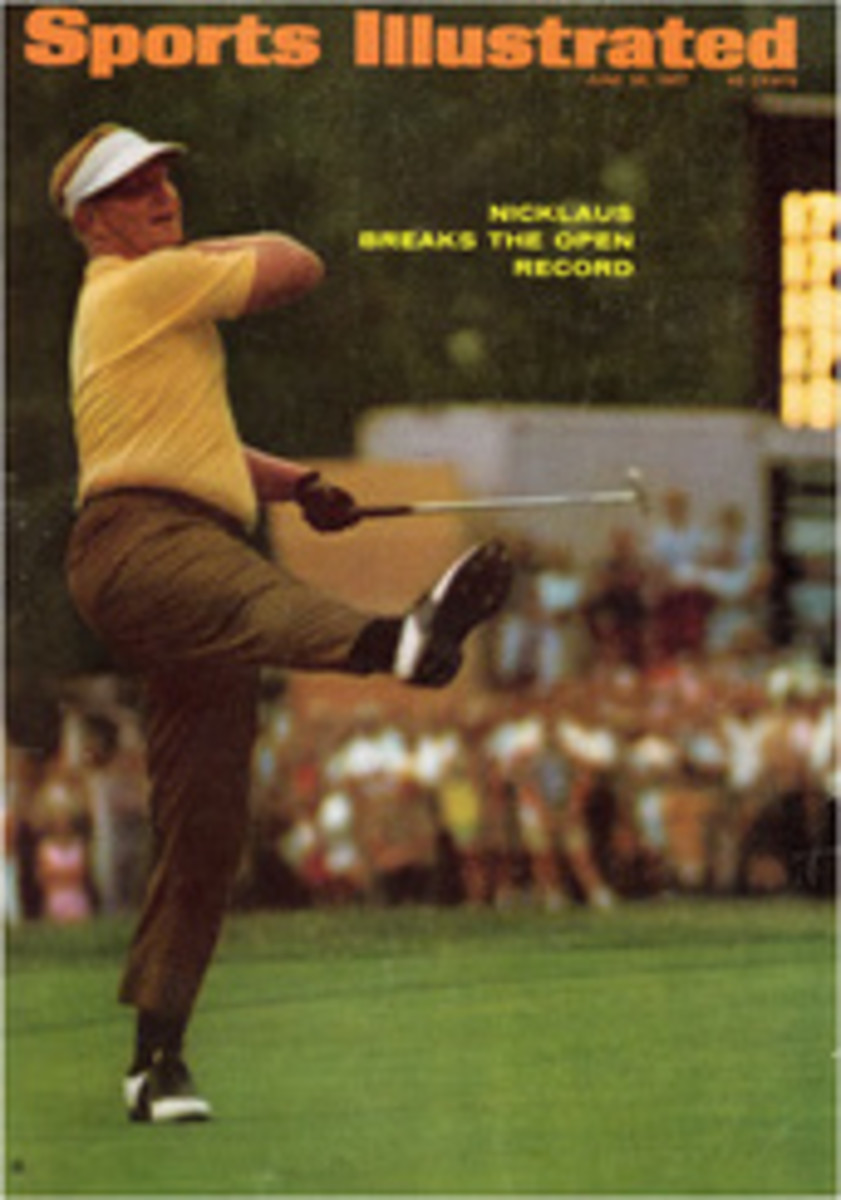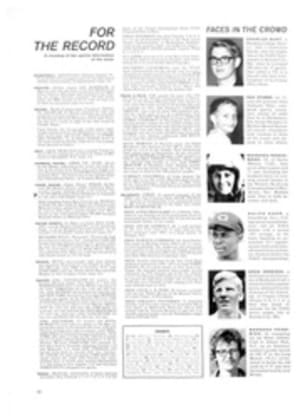
The Mets find a young phenom
After a road trip that was worse than usual, calamitous rather than merely disastrous, the 10th-place New York Mets returned last week to Shea Stadium where two of their nutty fans displayed a banner suggesting the hiring of Israel's General Moshe Dayan. A fine idea, except that the first opponent on the home stand was league-leading Cincinnati, and the closest any of the Reds had been to Egypt was Cairo, Ill.
The series started with a twi-night doubleheader, and Cincy easily won the first game behind the five-hit, shutout pitching of rookie Gary Nolan.
But in the second game the Mets produced their own special rookie pitcher, Tom Seaver, who beat the Reds 7-3 and showed a sample of his exceptional poise in the sixth inning. With runners on second and third and no outs, he forced Floyd Robinson to pop up and struck out Vada Pinson and Pete Rose. He tired in the ninth and lost his shutout, but the job was typical of what Seaver has been doing for the Mets in his second season of pro ball.
Against the Cubs he pitched a four-hitter over 10 innings and scored the winning run himself. Against Atlanta he lost a 4-3 game but hit two doubles and a single, stole a base and had two RBIs. He beat the Dodgers with a five-hitter and stole another base. Through last weekend Tom had a 5-4 record, praiseworthy on a basement team, and if his performance was un-Metlike, it was hardly unexpected by another team to which he happens to belong—the sharpshooting, par-busting, raisin-packing Seaver family out of Fresno, Calif. and points east.
The patriarch is Tom's father, Charles Seaver Sr., a fine amateur golfer. He was a two-handicapper at age 15, the same as he is today at the Sunnyside Country Club in Fresno. He was the Stanford University champion in 1932, beating Lawson Little, and the same year was on the Walker Cup team captained by Francis Ouimet. The elder Seaver also played football and basketball at Stanford, came within a hole of making the final round in the U.S. Amateur Championship in 1930 and a chance to meet Bobby Jones in his last match as an amateur, and, with Pro Mike Fetchick, won the Bing Crosby Pro-Am in 1964.
"He and Fetchick play together every year at the Crosby," said a veteran golf writer. "He's a great competitor, one of the few amateurs who can handle Pebble Beach, because he's so powerful. When there's wind and rain, Charles will be out there playing just as well as Fetchick."
Tom's mother is also a good golfer and a regular at Sunnyside. His Aunt Katie, friends remember, had no trouble lugging an old-fashioned 75-pound surfboard around the beaches of Hawaii. Another Katie, his oldest sister, was a good swimmer and volleyball player at Stanford and was famous around school for flattening a guy who got fresh with her one day at a campus pub. Brother Charles Jr., now a Brooklyn social worker who brings a batch of underprivileged kids to each home game Tom pitches, swam one year for the Cal varsity. Sister Carol was a physical education major at UCLA and spent two years in Nigeria with her husband, a Peace Corps official. It was no shock when Tom, the baby of the family, turned out to be a fine athlete.
He is also a soft-spoken gentleman of the Sandy Koufax school, autographing photographs, answering repetitious questions and accepting the wisecracks of his teammates, all without complaint. He is working toward a college degree in public relations and it shows. "Poised" is the adjective most often stuck on him.
"I don't find myself jumping up and down," he says. "I smile, but that's as far as I let my emotions carry me."
He recently joined a couple of his teammates in visiting the prisoners at Sing Sing, and on his first day off after coming home from the horrible road trip he went to a Bronx hospital and made a tape recording for the Bedside Network, a veterans' organization. He may be doing such things because he is a rookie and does not know how to turn people down, but more likely it is the same unostentatious idealism his brothers and sisters picked up somewhere in their Fresno upbringing.
Fresno is a pleasant place to grow up in. It lies in the middle of California's agriculture-rich San Joaquin Valley and consists mainly of farmers, Armenian merchants and budding baseball players (major league pitchers Wade Blasingame, Dick Ellsworth, Jim Maloney and Dick Selma also come from there). For excitement at night you can stew some figs or maybe drive over to Taft and watch the oil rigs bob up and down in the moonlight. The sun shines brightly nearly every day, and boxes of raisins are shipped out regularly from the packing company where Tom's father is vice president.
Almost every Sunday when Tom was a boy his parents would golf at Sunnyside while the young Seavers ducked each other in the club swimming pool. The three males in the family hunted quail at every opportunity in the nearby foothills. Tom is a right-handed pitcher, batter and writer, but for some reason he shoots left-handed. During a short hitch in the Marines a sergeant insisted he switch over.
"Out he came with an eye patch," said his father, "put it over his left eye and in two weeks he was an expert marksman with his right hand. Now he's back to shooting left-handed."
"Pop is the best hunter," said Charles Jr. "At Christmas we were all home. We hunted quail and he left us in the dust. Tom's a professional athlete but Dad was leaving him behind. He'd go bouncing over the hills and then wait for us. He's like a mountain goat."
Tom was a good basketball and baseball player at Fresno High, yet not one scout so much as nodded to him. He was small, and his fast ball would not squash a grape. But Marine Corps mess halls accomplished what years of raisins and quails could not. He went in the corps for six months, worked at his father's plant for six months and entered Fresno City College four inches taller (6'1") and 45 pounds heavier (190).
After a good season at Fresno City College and a summer in Fairbanks pitching for the Alaska Goldpanners, Tom was given a baseball grant-in-aid by USC, one of the few big universities in the state that had been Seaverless. Trojan Coach Rod Dedeaux is a successful trucking executive who, as a sideline, develops major league talent and wins championships.
As a junior Seaver had a 10-2 record and struck out 100 batters in 106 innings. He roomed with Coach Dedeaux's son, Justin, and left Justin strongly impressed with his pitching, his cooking of self-shot pheasant and his running, which the Mets have come to appreciate, too.
"His speed fools you," says Justin. "He's one of the best base runners I've ever seen. He studies the pitchers, knows their moves, knows their little idiosyncrasies, and this gives him the jump.
"Dad used to have the team run wind sprints, and Tom could almost run nose to nose with Mike Garrett. Mike might win one time by a stride at 75 yards. The next time they'd dead-heat. Once in a while Tom might have an edge."
The Dodgers picked Seaver in the free-agent draft of June 1965 but made no effort to sign him. He was available again in the January 1966 draft, so the Braves picked him and began negotiations. When he was signed for a bonus of about $50,000, the USC baseball season already had started—which is too late to sign a college ballplayer, according to current baseball law—but the Braves assured him everything was O.K. as long as the Trojans' league games had not started.
Dedeaux was not exactly overjoyed (Ron Fairly of the Dodgers, Barry Lat-man of the Astros and Gary Sutherland of the Phils are some other players he lost while they had eligibility left), but Tom and his girl friend, Nancy, were happy, for now they could get married. His parents planned a gala party in Fresno for 60 or 70 of their friends. One hour before the first cork was to pop, Braves General Manager John McHale phoned and told Tom that the commissioner's office had voided the contract. It turned out that the rule held whether the games were in league or out. The party went on anyway.
Tom would have rejoined the Trojans, but the NCAA declared him ineligible. Suddenly he was not only $50,000 poorer, he was a man without a country, neither pro nor amateur. In the flurry of phone calls that followed, from Fresno to Atlanta to the baseball commissioner's office, Seaver occasionally found himself wondering whether he was talking to MacPhail (Lee) of the commissioner's office or McHale (John) of the Braves.
Commissioner Eckert finally ruled that any club but the Braves that was willing to pick up the $50,000 bonus tab could put in a claim for Seaver. The Phillies, Indians and Mets stepped forward and, as Tom listened via long-distance telephone, New York's name was picked out of a hat, perhaps John McHale's.
That is how the Mets—who have lived so long with bad luck—came up with a base-stealing, right-hand-throwing, left-hand-shooting pitching phenom, and how USC lost the national baseball championship. The Trojans, without Tom, went to the college World Series at Omaha in 1966 and lost to Ohio State 1-0 (the Buckeye pitcher, Steve Arlin, subsequently signed with the Phillies for a $100,000 bonus). If Seaver had been pitching that day, muses Rod Dedeaux, "the game might still be in extra innings."
PHOTO
YOUTHFUL SEAVER AFTER WIN OVER REDS

